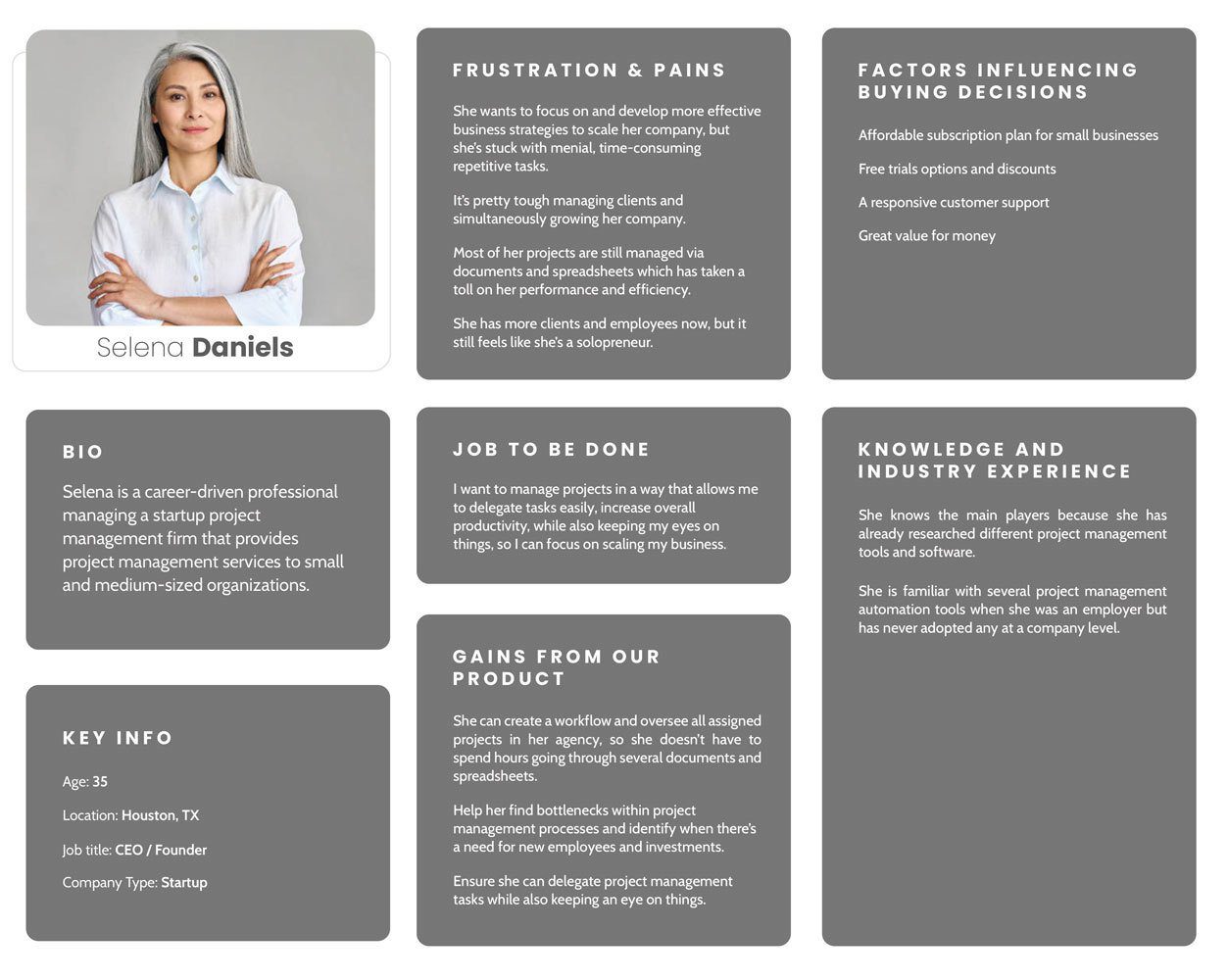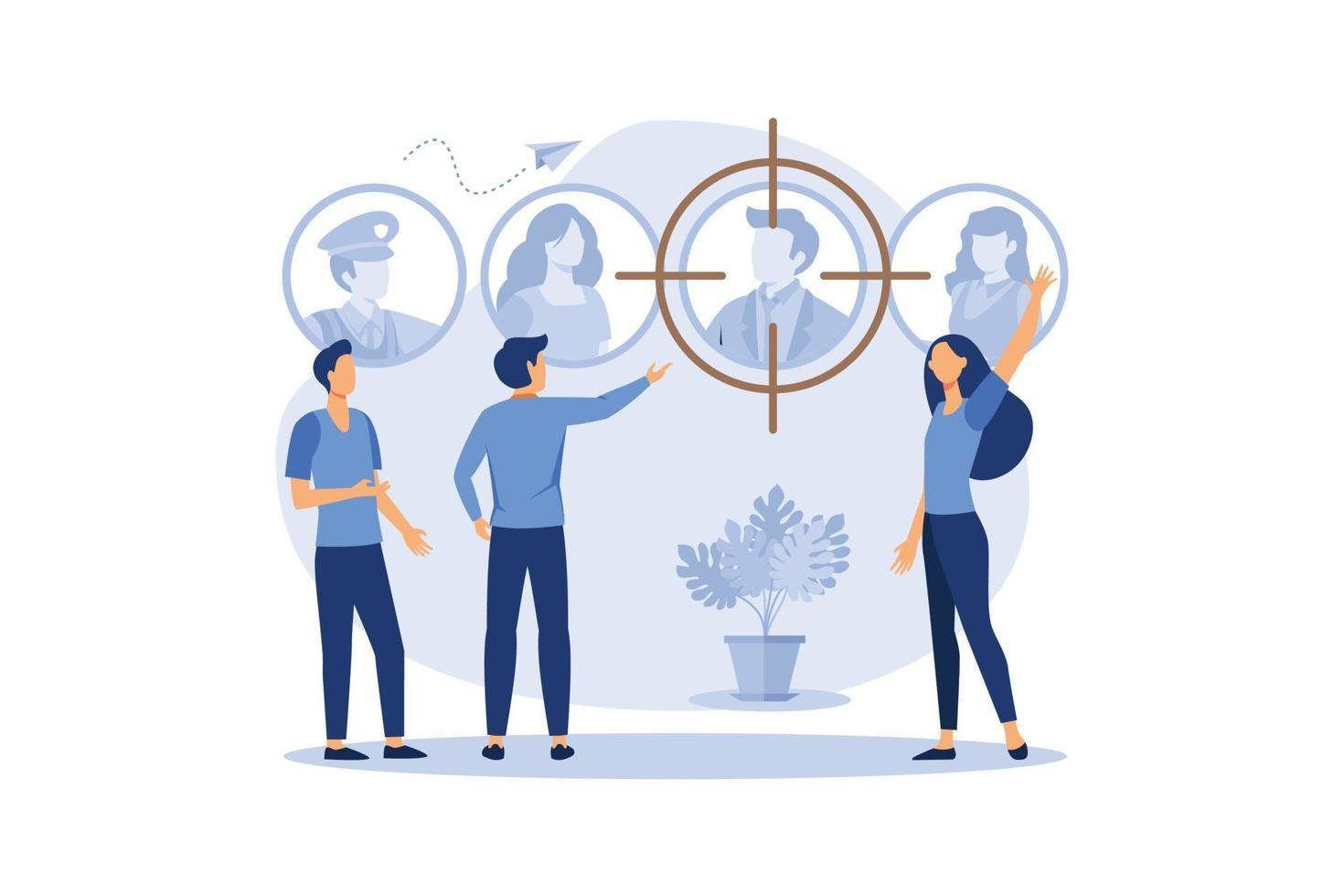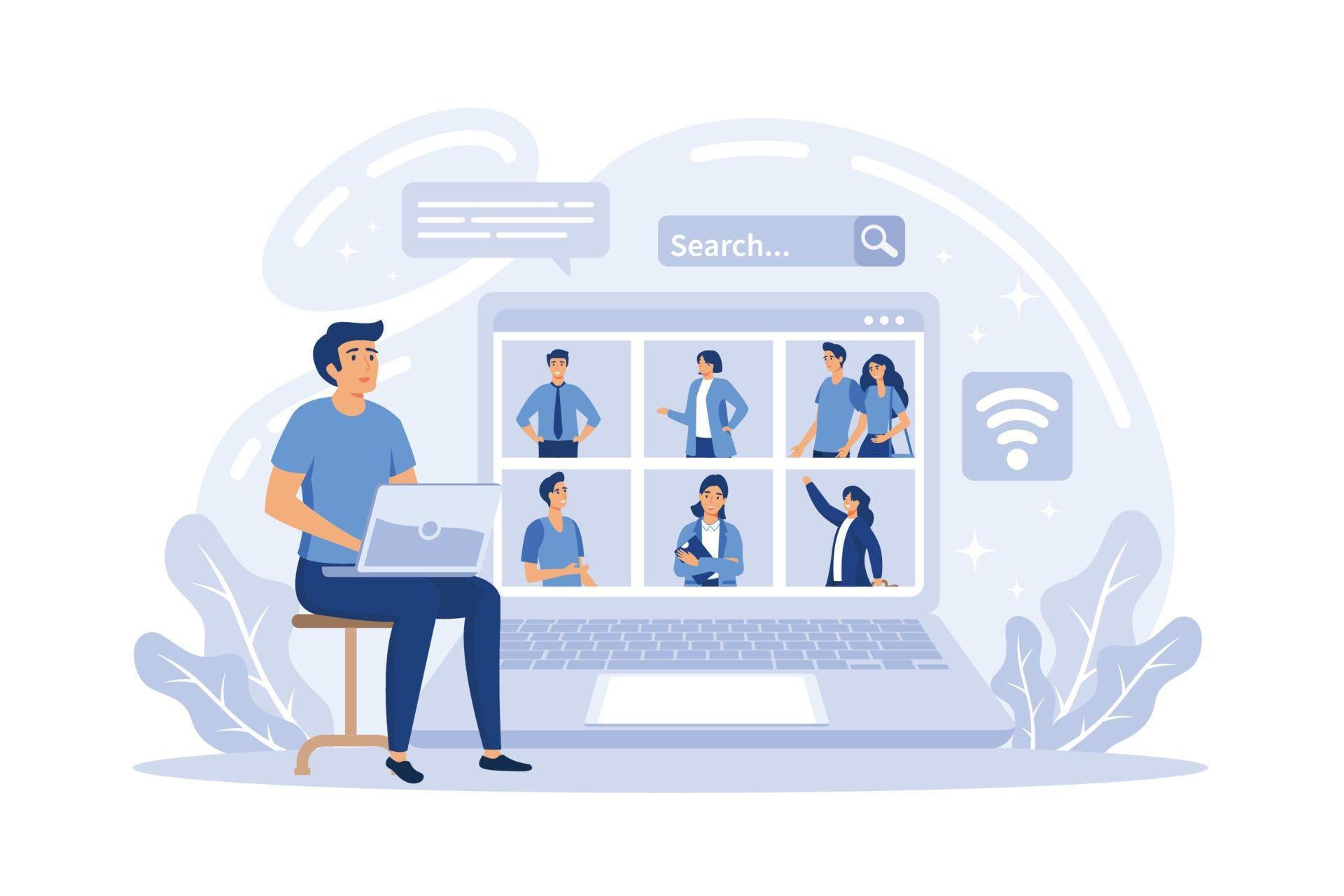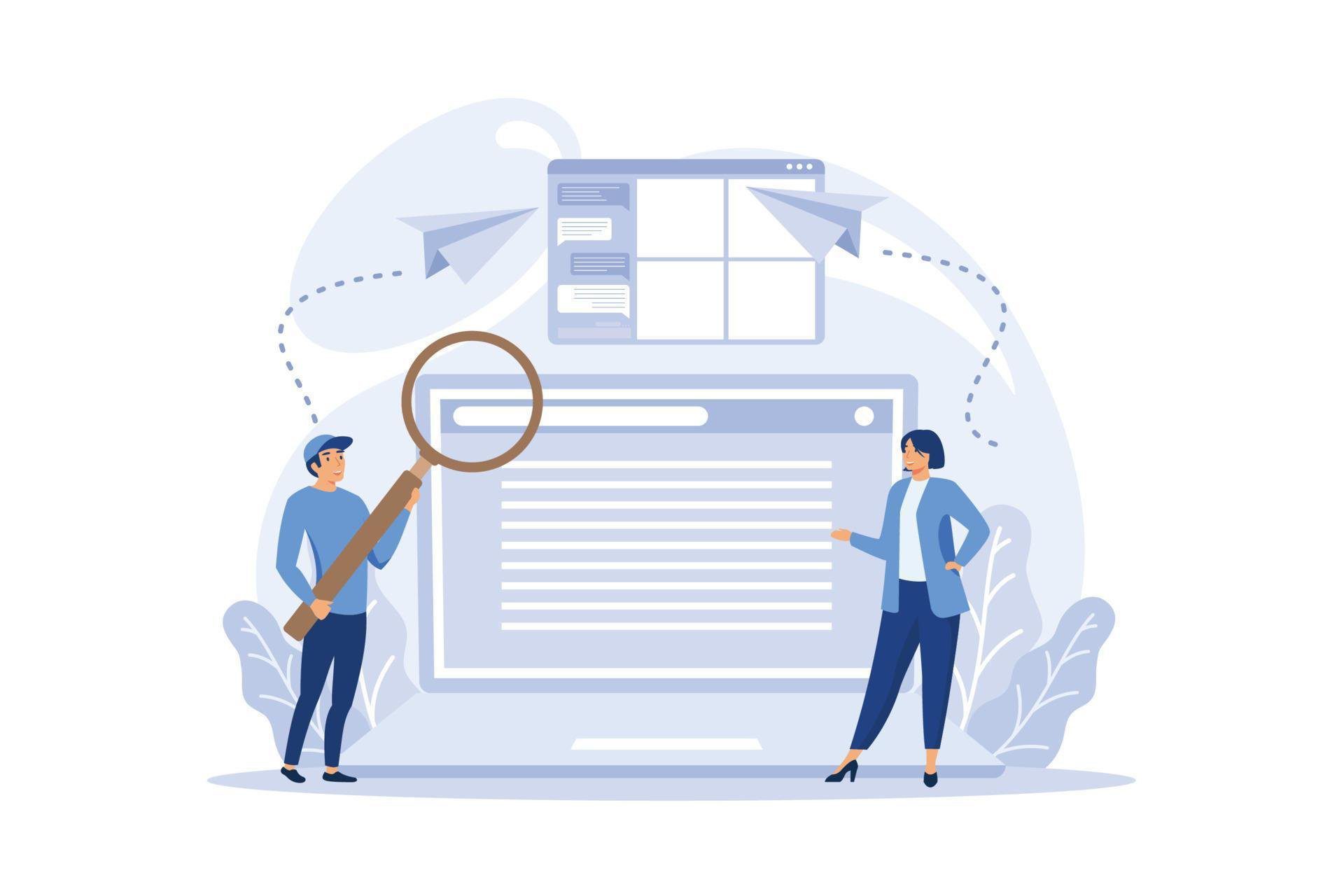“Get closer to your customers than ever before, so close that you can tell them what they need well before they realize it themselves.” -Steve Jobs
So, how can you get close to your customers? How do you identify their needs?
Since you landed on this article, you can probably already guess—by creating a buyer persona.
A buyer persona helps you identify your target customers so that you can deliver customized content and an overall personalized experience for each of them. It also helps you refine your inbound marketing strategy and streamline your sales process to improve conversions.
In this guide, we’ll walk you through how to create an effective buyer persona for your business. We have also created some examples and a free buyer persona template that you can use to optimize your marketing campaigns. Let’s get down to business.

What Are Buyer Personas?
Buyer personas are fictitious representations of your ideal customers, created from research, data, and interviews with your existing customers. They’re only semi-fictional because they’re not actual people, but they represent your best customer. Buyer personas highlight the customers who give you the most revenue, with the least objection, over the longest possible time.
Although buyer personas are mostly used in marketing, you should keep in mind how they affect all departments across your entire company. In fact, they should be embraced in sales, service, and finance just the way they are in marketing. 93% of businesses that meet and exceed their revenue targets use buyer personas.
In other words, a buyer persona helps you focus your resources on qualified customers and develop marketing, sales, and service collateral along with products that suit their needs.
With a buyer persona, you’ll have answers to questions like:
- What content generates the right engagement from your target customers?
- What drives your customers to make purchases?
- What is the problem of your customers, and how does your business help them?
A deep understanding of your buyer persona is essential for sales follow-up, content creation, product development, and everything that relates to lead generation, conversion, and customer retention. Luckily, it’s quite easy to create a buyer persona for your business. You only have to know how to conduct market research, obtain customer data, and use it to optimize your business strategies.
Why Is a Buyer Persona Important?
- Focus: A buyer persona ensures that everyone in your organization, across all departments, has a shared understanding of your ideal customer(s). When you understand your customers, creating content that speaks directly to them becomes easier. This will also help your team pay attention to and create marketing messages that address your customers’ needs.
- Strategy: Never assume that you know what your customers need or want until you’ve carried out research and identified the problems your product or service will help them solve. Creating a buyer persona helps you to identify the problems and ways you can help them to solve them. Once you know your customers’ problems, you can begin to craft effective and laser-targeted inbound marketing strategies to tackle these problems.
- Objectivity: As a business owner, marketing consultation manager, or sales manager, creating multiple buyer personas will help you identify and understand different types of customers. In turn, you’ll be able to design content and communication pieces from different perspectives, without using tunnel vision.
Types of Buyer Personas
There is no uniform list or types of buyer personas since each business is unique, and personas are custom to them. However, there are three types of buyer personas you should ideally build or be aware of for your business.
- The Decision Makers: These are people who know exactly what they want and can make decisions to either buy a product and/or service or not. They may take suggestions from people, but the decision to make a purchase ultimately lies with them. For example, a director of marketing looking to migrate to a new CRM.
- The Information Seekers: These are people who do research and look for information online and offline to help them make informed decisions before buying a product and/or service. They seek advice and suggestions from influencers and experts before making purchases. They also usually have to pitch purchases internally before moving forward. An example here is an intern who is researching social media software to use for their manager.
- The Influencers: These are experts in certain areas or subject matters who advise people on what product to buy. They are not necessarily buyers themselves, but they can sway both the information seekers and decision-makers in certain ways because people believe it is important to consider their opinion before making a purchase. A good example is an accountant who advises companies on which accounting software is best to purchase.
Buyer Persona Examples
Depending on whether you’re a B2B (business to business) company or a B2C (business to customer) organization, your buyer personas should be crafted in a way that directly represents your target customers. For example, you might want to focus on demographic information rather than professional experience when creating a B2C persona, and vice versa.
However, regardless of the type of customers that your business caters to, your goal should remain universal. You’ll need to:
- Understand your customers’ problems
- Identify what drives them to make purchases
- Determine the best way to offer them your solutions
Again, not all information about your customers will be relevant when creating a buyer persona. Ensure that all the info generated from your customer analysis is actionable before adding it to your buyer personas. For example, if knowing where your lead works won’t change anything in your inbound marketing strategy, then there’s no need to include the information in the buyer persona.
B2C Buyer Persona Example
The picture below is a B2C Buyer Persona for Amanda Taylor, a Pasta shop customer. A glimpse into Amanda’s life gives us an idea of what a day in her life looks like. It also shows us her worries and fears, needs, hopes, dreams, background, finances, online behaviors, and what would make her life easier. Her influences are also important things to note in getting to know and understanding her personality.
Based on this buyer persona, the Pasta shop would want to ensure they provide a serene atmosphere for Amanda to relax and enjoy her meal after a long day or week, offer her deals on purchases via discounts or coupons, and maybe develop an application that makes it easy for her to order pasta.

B2B Buyer Persona Example
The picture below is a B2B Buyer Persona for Selena Daniels, who is the Founder/CEO of a startup project management firm. One of the major differences between a B2B and B2C buyer persona is the in-depth info provided about the person’s function in the organization. For B2B businesses, having a deep understanding of the person’s position in the company will help you determine how much influence they have on purchasing decisions.
The persona clearly shows that she’s the primary decision-maker in the company. It also shows her pain points and what she stands to gain from using your product (a project management tool that helps her to automate operations and delegate project management tasks).

How Do You Conduct Buyer Persona Research?
Understanding what makes your customers tick is a daunting task. It involves talking to actual people in an attempt to get to know them and understand their perspectives, and surveys. You’ll have to carry out research and interview your prospects, customers, and other people who may identify as your target customers.
However, if you break down the process into smaller, practical steps and go through them one after the other, you’ll develop buyer personas that will genuinely improve your inbound marketing strategy.
So how do you start? What questions should you ask? How do you draw inferences from their answers?
Here are some practical steps for conducting a buyer persona study:

1. Start from Within
Start building your persona from within. Ask questions and have conversations with the teams from different departments in your company to ensure everyone is on the same page. Consult the staff in marketing, sales, customer service, and other departments relevant to your current objectives.
The goal of these internal meetings is to learn from them, the pain points, common behaviors, goals, and interests of your customers. In turn, explain to them in simple terms what buyer personas are and how they can positively fine-tune relationships with customers.
a) Interview with Sales Team
Sales consultancy usually gives the best insight into the factors that influence a customer’s decision to buy a product and/or service or not. Your sales team will also know the questions that are frequently asked, the most common objections, and the unique selling points most relevant to your target audience.
With these insights, ask the following questions to draw out more useful information for your persona development:
- What kinds of customers do you encounter?
- Why do different types of customers buy our product(s)?
- What are their reasons for going with our services instead of our competitors?
- What are their most common objections?
b) Interview with Marketing Team
Marketing consultation with your team will tell you how customers find your company and how they engage with your content. This will, in turn, help you identify those you need to reach and the best way to reach them.
- How do you market right now?
- What are our most successful marketing campaigns?
- What are the most commonly asked questions?
- Which of our content gets the most engagement?
- How much technical and demographic data do you have on your website’s visitors?

Questions to Ask Your Customers When Conducting a Buyer Persona
These are general questions you may ask your customers, but you can customize them to suit the information you need from them.
a) Demographic Questions
These are basic background details about the customer. Ask questions relating to their marital status, place of residence, income level, gender, age, level of education, course of study, career path, and whether they have kids or not. Before choosing any or all of these, be careful to know whether asking for this information would deter your customers and only choose those that will not offend them.
b) Career Questions
If you’re a B2B company, then you’ll need this info to develop your persona. Ask your respondent about their current industry and the level they aspire to attain in their career.
c) Job or Role Questions
This is also important for creating B2B buyer personas. Ask about their current role, the title of their position, how their job is measured, what a typical day at work looks like, what skills are required for the job, tools needed for their job, who reports to them, and/or who they report to.
d) Daily Life Questions
Daily life questions help you to understand what a typical day in their lives looks like. B2B and B2C businesses can use this technique. Relevant questions to ask include: what a typical day in their lives looks like, what they do for fun, how much time they spend at work, school and home, whether they own a car or use public transportation, what they watch on TV, who are the most important people in their lives, etc.
e) Challenges or Pain Points Questions
Ask them about their biggest challenges—these could be about family, finances, work, school, health, or society at large. What makes them nervous? What activities do they find stressful? What part of their job do they find frustrating? What sort of help do they wish to have at work? What are the top three things on their bucket list? And so on.
f) Customer Behavior Questions
Customer behavior is quite difficult to predict, which is why it is important to create personas. Ask how they learned about your product, what they think of your product and service delivery, what they consider a good deal, where they prefer shopping/paying, what social media they use, the mobile device they use, and what they think of your customer support, etc.

2. Organize Your Data and Categorize Common Details
Once you’ve completed the interviews, organize your data into a buyer persona template by putting similar answers from customers into categories to narrow down your results. These are some of the categories that you can group them into:
- Demographics – age, occupation, marital status, location, gender, etc.
- Pain points and Challenges
- Interests – hobbies, social media, fashion, sports, entertainment, arts, etc.
- Behaviors – shopping habits or preferences, skill level, position about your product and service delivery, etc.
- Company Size – small, medium, and large organizations, private or public owned, profit or non-non-profit, etc.
- Industry – Finance, Tech, Education, Agriculture, etc.
3. Create Your Personas
Now that you have placed customers with common information into categories, use the info to create different personas. Do this by identifying customers with the same goals and challenges and placing them in the same categories in a buyer persona template. Then, use the different categories to create different personas.
For example, if you run a gym and fitness center, you may have customers who want to lose weight and others who want to add weight and muscle. Place them in categories based on their goals and create personas for each group.
4. Name Your Persona and Tell Its Story
Once you’ve created your buyer personas, it’s time to name them, tell their stories, and put them in the hands of those who need them. Assign a name that resonates with an actual person. Create a story that highlights their problems, how they can find you, and what they need.
After naming and creating their story, it’s time for your team to meet your personas. You can present your personas in a presentation to the relevant team members of a key department in your organization. Get them to become familiar with the names, challenges, objections, goals, interests, and demographics of each buyer persona.
5. Craft a Marketing Message for Your Persona
Lastly, craft your marketing messages and content with your persona in mind. Tell people about your product and service with the pain points and challenges of your persona in mind, and let them know how your product can provide the solutions they’re looking for.
Use personalized email, blog posts, web content, and social media posts to target each persona.
This will ensure that everyone in your team or company is on the same page, speaking the same language, and having the same conversations with your leads and customers.
That’s it—you’re good to go, and can use your new Buyer Personas to target, convert and retain clients.
Think you need more consultation on how to scale your business to new heights? You most likely do. Book a free consultation today


